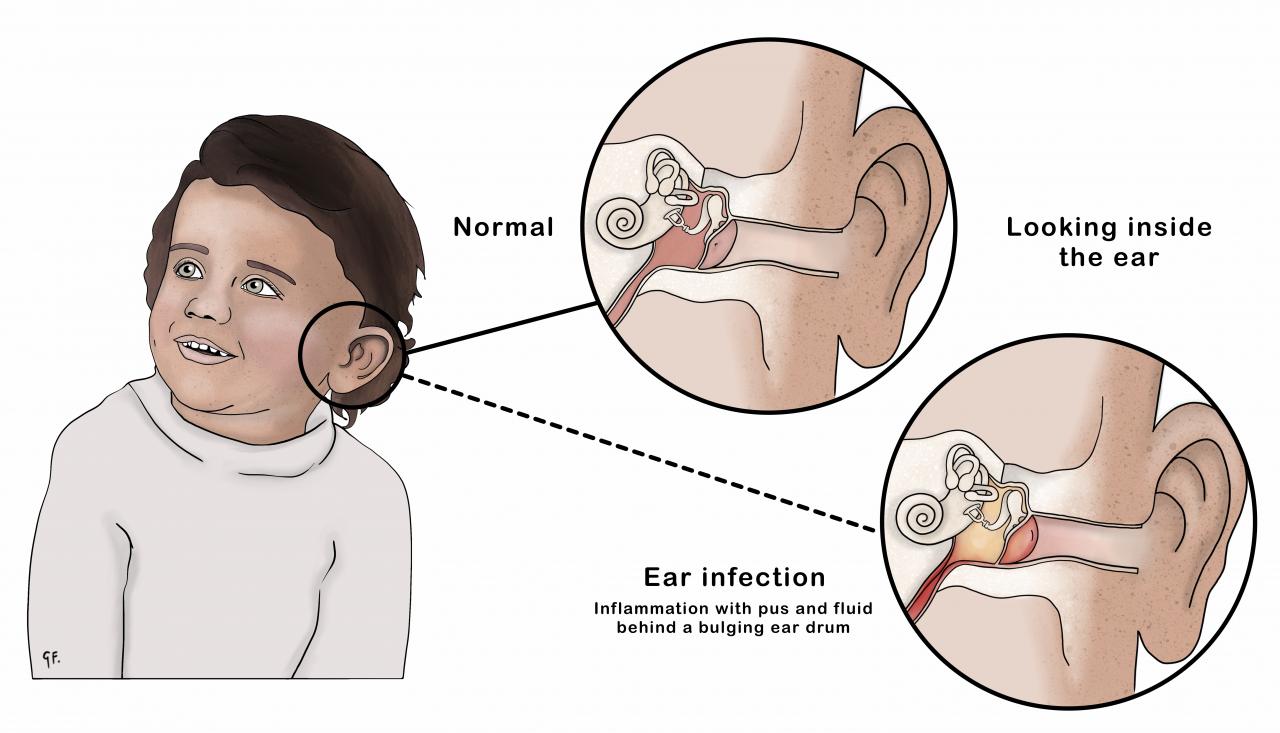Ear Infections In Detail
Ear Infections In Detail
Ear pain and concerns about hearing are one of the most common reasons parents take their young children to the doctor.
Key points about ear infections
If you think your child has an ear infection, take them to your family doctor.
- ear infections are very common in young children
- they can cause pain, and often fever
- if you think your child has an ear infection, take them to your family doctor
- pain relief is important
- antibiotics are often not needed
- always take your child to your family doctor for an ear check 4 to 6 weeks after an ear infection, to make sure the ear fluid has gone
- most children outgrow ear infections and will have perfect, undamaged ears and normal hearing
What does the inside of the ear look like?
The inside of the ear can be separated into three parts, the outer, middle and inner ear.
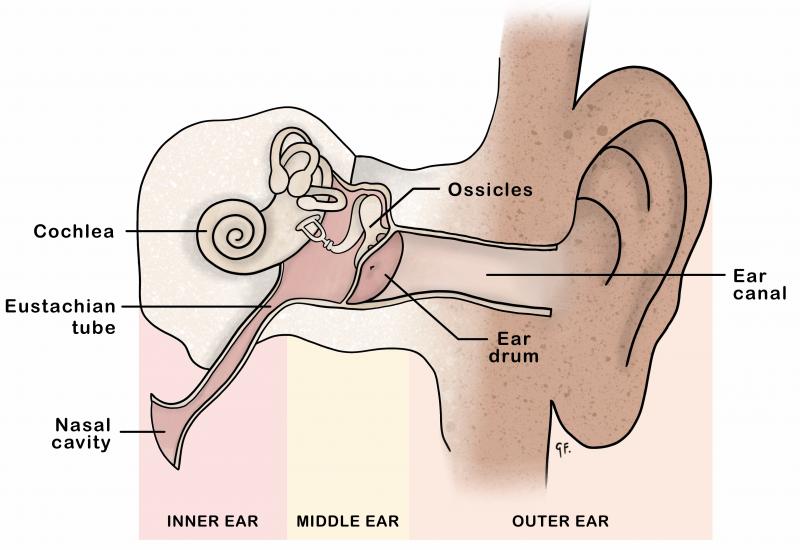
What is an ear infection?
Ear pain and concerns about hearing are one of the most common reasons parents take their young children to the doctor. The medical name for an ear infection is 'otitis media'.
There are 2 common types of middle ear problems:
- an ear infection (acute otitis media) – discussed on this page
- glue ear (otitis media with effusion or secretory otitis media)
How do ear infections happen?
Ear infections often happen either during or just after a cold, in the following way:
- bacteria or viruses from a cold travel up the eustachian tube which connects the space behind the ear drum (middle ear) to the back of the nose
- the infection causes swelling and inflammation of the eustachian tube, so it can get blocked
- the blocked eustachian tube means air cannot reach the middle ear
- fluid and pus collects in the middle ear
- the eardrum bulges out and becomes red and painful
- the rapid stretching of the ear drum causes your child pain, and the infective process can cause fever
The image below shows a healthy ear with no infection.
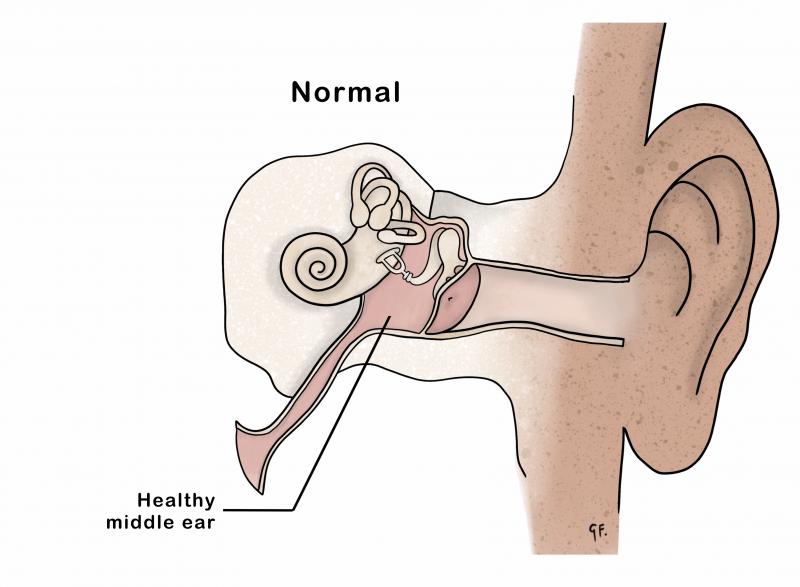
The image below shows an ear infection.
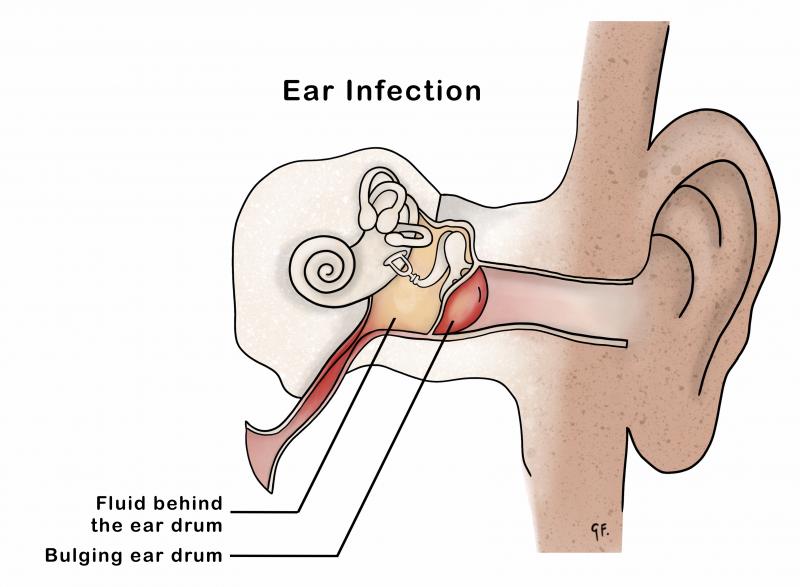
Who gets ear infections?
Ear infections are very common in babies and young children who are more likely to develop them than older children and adults. This is because their eustachian tubes (connecting the middle ear to the back of the nose) don't function as well as in older children and adults - the tubes are smaller, shorter and flatter (more horizontal).
As children grow older, their eustachian tubes work better and they get fewer colds. As a result, they outgrow the tendency to have ear infections at around 7 years of age. But, some children may have problems beyond this age.
What puts my child at risk of getting ear infections?
We know some important risk factors, but not all the reasons why some children develop more ear infections than others. The most important risk factors include:
- a family history of ear infections
- living with someone who smokes
- going to early childcare - babies and children are exposed to more colds and viruses
- having an older brother or sister in childcare or early primary school also increases the risk
- season of the year - ear infections are more common during the autumn and winter months
There is no clear evidence that allergy causes ear infections.
What are the signs and symptoms of an ear infection?
The pain from an ear infection comes on rapidly and doesn't last long. It usually wears off within 24 hours.
Symptoms in older children
Older children will complain of significant ear pain and may have a fever. They may also feel unwell and complain of reduced hearing in the affected ear. They may complain of problems with balance.
Symptoms in babies and younger children
In babies and younger children, sometimes the only sign of an ear infection is a fever.
Younger children may also:
- cry and become very upset, distressed, irritable and hard to settle
- have very disturbed sleep at the beginning of the infection
- become 'clingy' and 'grizzly'
Burst ear drum
Sometimes pus will burst through the eardrum. The pus looks like snot coming out of the ear. When the eardrum bursts, children often feel better as the pressure causing the pain is suddenly released. The burst eardrum usually heals without treatment or future problems.
See your family doctor if this happens. Your doctor may give your child antibiotic ear drops.
The image below shows an ear infection that has led to a burst ear drum.
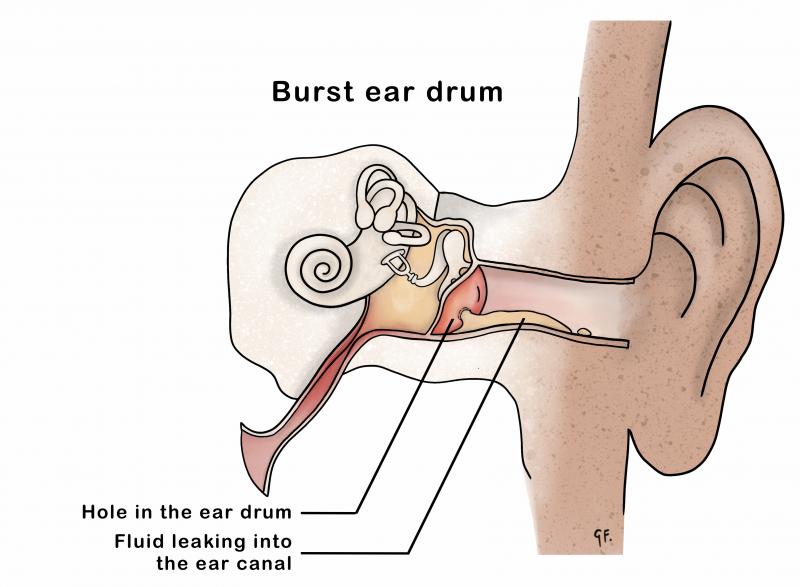
Can you catch middle ear infections?
Ear infections cannot be passed on from one person to another, but the cold or other infection which caused them can.
Should I take my child to a health professional?
If you think your child may have an ear infection, take them to your doctor or nurse practitioner. They will talk with you about what you have noticed in your child and look into their ears with an otoscope. An otoscope is a small powerful light with a magnifying lens.
How can I hold my child while the doctor looks in their ears?
Most babies and children do not like having their ears examined. To make it easier, your doctor will probably encourage you to:
- hold your child sitting sideways on your lap
- hug their arms firmly with one of your arms
- hold their head firmly against your chest with your other arm
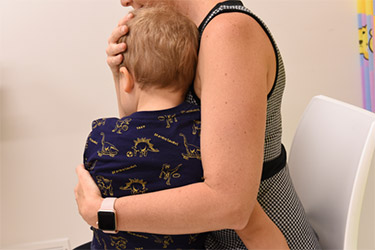
What is the treatment for an ear infection?
Pain relief
Regular pain relief is important to help your child feel more comfortable. Paracetamol and/or ibuprofen can help reduce pain, and also lower fever which can make your child feel better. You must follow the dosage instructions on the bottle. It is dangerous to give more than the recommended dose.
Antibiotics
Ear infections do not usually need treatment with antibiotics. After one week, at least 3 out of 4 children will be better whether they take antibiotics or not.
The decision about whether or not to use antibiotics may depend on some of the following:
- whether your child has a high fever or severe pain
- how old your child is - your doctor is more likely to give antibiotics if your child is under 3 years old
- if your child still has pain or discomfort after 48 hours of pain relief
- how often your child has had middle ear infections before
- whether your child has ever had complications from ear infections before
- whether your child has any other medical conditions
- your views on how to manage your child's ear problems
How can I care for my child with an ear infection at home?
- give your child the pain relief suggested by your doctor
- your child may need rest and lots of comforting and cuddles
- keep your child home from child care or school while they are unwell or have a fever
There is no evidence that decongestant medicines (including nose sprays) and antihistamines are of any benefit in the treatment of acute ear infections. Don't use them as they can have unwanted side-effects.
How long does an ear infection last?
The pain from an ear infection comes on rapidly and doesn't last long. It usually wears off within 24 hours.
After an ear infection, your child may have fluid behind their eardrum (effusion). This can last several weeks to months. It may cause your child to have a continuing feeling of discomfort in their ears. It is more a dull, abnormal feeling than a nasty, sharp pain. The fluid also causes a short-term decrease in hearing in that ear.
When should I take my child with an ear infection back to the doctor?
Once an ear infection is diagnosed, your child should start to improve within 24 to 48 hours. Go back to your doctor if:
- an earache is not settling after 2 days
- fluid starts coming out of your child's ear
- your child seems more unwell
There are some very rare complications of ear infections. You need to go back to a doctor immediately if your child:
- has any swelling, redness or tenderness in or around the ear (this could be mastoiditis)
- is feeding poorly
- is floppy, sleepy or drowsy
- is becoming less responsive
- is not interested in surroundings (lethargic)
- complains of a stiff neck or light hurting their eyes (this could be meningitis)
Always take your child to your family doctor for an ear check 4 to 6 weeks after any ear infection, to make sure the ear fluid has gone.
Always take your child to your family doctor for an ear check after any ear infection, to make sure the ear fluid has gone. Go to your doctor again 4 to 6 weeks after the ear infection.
Frequent ear infections
If your child gets frequent ear infections, they may need to see an ENT (ear, nose and throat) specialist to consider grommets.
Are there any long-term complications from ear infections?
Most children outgrow ear infections and will have perfect, undamaged ears and normal hearing.
The fluid that collects behind the eardrum (called an effusion) can last for weeks to months after the pain of an ear infection is over. Within 12 weeks, the fluid is usually gone in 8 out of 10 children.
Hearing loss
Hearing loss is the main complication of ear infections. Make sure your child has the B4 School Check and has their hearing tested.
The hearing and vision section has information about hearing problems and hearing checks for babies and children.
Check out the hearing and vision section
Read about how hearing is important for your child's communication development
A hole in the eardrum that doesn't heal
If your child has had a hole in the eardrum (eardrum perforation), it can become long-lasting with fluid leaking from the ear. Sometimes an operation to repair the perforation may be necessary but usually not before the age of 8.
Can I do anything to prevent ear infections in my child?
It is not easy to prevent ear infections, but the following may help reduce the risk:
- making sure your child's environment is smoke-free.
- breastfeeding your baby for at least 3 to 6 months is thought to be protective against the early development of ear infections - this may be because breastfeeding boosts the infection-fighting system (immune system)
- keeping your child's room warm and dry
- making sure your child has all their immunisations on time
This page last reviewed 30 November 2021.
Do you have any feedback for KidsHealth?
If you have any feedback about the KidsHealth website, or have a suggestion for new content, please get in touch with us.
Email us now